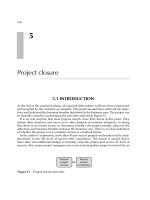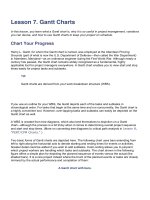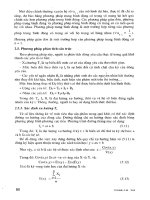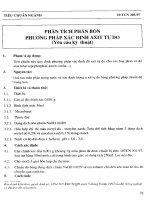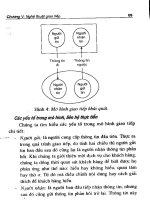MARKETING RESEARCH PART 4 ppt
Bạn đang xem bản rút gọn của tài liệu. Xem và tải ngay bản đầy đủ của tài liệu tại đây (184.38 KB, 40 trang )
Defining the Problem
and Determining
Research Objectives
Ch 4 2
The Importance of Properly
Defining the Problem
• Properly defining the problem is the
most important step in the marketing
research process.
• If the wrong problem is defined, all
the remaining steps in the marketing
research process are wrong.
Ch 4 3
Define the Problem
• Two sources of problems:
–A problem exists when a gap exists
between what was supposed
to
happen and what did
happen, i.e.,
failure to meet an objective.
–An opportunity occurs when there
is a gap between what did
happen
and what could
have
happened…called an opportunity.
Ch 4 4
Define the Problem
Ch 4 5
Recognizing the Problem
• To recognize a problem, managers
must be knowledgeable of objectives
and actual performance.
• To be aware of opportunities,
managers must have a process for
monitoring opportunities, such as
opportunity identification.
Ch 4 6
The Role of Symptoms in
Problem Recognition
• “We have a problem … we are losing
money”
–Managers must be careful to avoid
confusing symptoms with
problems.
Ch 4 7
The Role of Symptoms in
Problem Recognition
• Symptoms are changes in the level of
some key monitor that measures the
achievement of an objective.
• The role of the symptom is to alert
management to a problem; there is a
gap between what should
be
happening and what is
happening.
Ch 4 8
The Role of the Researcher in
Problem Definition
• Researchers should ensure
managers are defining the problem
correctly.
• This is particularly true when the
manager has already defined the
problem in very specific terms.
• Researchers sometimes take
additional investigations, known as a
“situation analysis,” to ensure the
problem is adequately defined.
Ch 4 9
Impediments to Problem
Definition
• Failure to change behavior for
problem definition situations
–Managers deal with outside
suppliers efficiently with little
interaction. Marketing research
requires a great deal of interaction
and communication.
Ch 4 10
Impediments to Problem
Definition
• There are differences between
managers’ and researchers’
backgrounds.
–Traditionally researchers were
technicians and managers were
trained in general decision making.
–Today managers are much more
aware of technical software such
as using your SPSS.
Ch 4 11
The Role of ITBs and RFPs
• ITBs are Invitations to Bid.
• RFPs are Requests for Proposals.
• When ITBs and RFPs are issued
management has already defined the
problem.
• Phony ITBs and RFPs present an
ethical problem in the marketing
research industry.
Ch 4 12
Defining the Problem &
Establishing Research Objectives
• A Process:
–There is no universally accepted,
step-by-step approach used by
marketing researchers to define the
problem and establish research
objectives.
• “Defining problems accurately is more
an art than a science.” – Lawrence D.
Gibson
Ch 4 13
Assess the Background and the
Manager’s Situation
• The researcher should first
understand the industry, the
competitors, and the company.
• The researcher must understand the
manager’s unique situation…
–Does the manager have a
particular objective?
–What constraints is the manager
operating under?
Ch 4 14
Clarify the Symptoms of the
Problem
• The researcher must understand the
control system and determine what
symptoms are being identified by the
system.
Ch 4 15
Pinpoint Suspected Causes of
the Symptom
• There’s always some cause or
causes for a change.
• It is important to determine all
possible causes.
• Researchers should narrow possible
causes to a small set of probable
causes.
Ch 4 16
University Estates – Problem
Definition & Research Objectives
• Situation: Last year, University
Estates (which targets mainly
university students) experienced a
decline in its occupancy rate from
100% to 80%.
• Manager & Researcher brainstorm a
list of POSSIBLE CAUSES
Wait! You give it a try.
Ch 4 17
University Estates – Problem
Definition & Research Objectives
• What are some possible cases for
University Estates’ Occupancy
Decline?
Ch 4 18
University Estates – Problem
Definition & Research Objectives
Ch 4 19
University Estates – Problem
Definition & Research Objectives
• What is/are the probable cause(s) for
University Estates Occupancy Rate
Decline?
–Something that changed just
before or at the same time as the
symptom(s).
• If it did not change, how could it
cause the symptom?
Ch 4 20
• Probable Causes for University Estates
Occupancy Rate Decline
1. Competitor’s Actions
Basic Cable TV
2. Consumers (Current
and Prospective Student
Renters)
No change
3. University Estates Itself
No change
4. The Environment
No change
Probable Cause
University Estates – Problem
Definition & Research Objectives
Probable Cause
Probable Cause
Probable Cause
Ch 4 21
University Estates – Problem
Definition & Research Objectives
• What can University Estates do?
Add Satellite TV
150 channels
4 Premium channels
Pay-for-view
Ch 4 22
Specify Possible Solutions that
May Alleviate the Symptoms
• Possible solutions include any
marketing action that the marketing
manager thinks may solve the
problem, such as price changes,
product modification, etc.
Ch 4 23
Speculate on Anticipated
Consequences of the Solutions
• “What if” questions should be made
regarding possible consequences of
each marketing action being
considered.
Ch 4 24
Identify Manager’s Assumptions
about Solutions’ Consequences
• Assumptions are assertions that
certain conditions exist or certain
reactions will take place if considered
solutions are implemented.
• If the manager is completely certain
of assumptions there is no need for
research.
Ch 4 25
Identify Manager’s Assumptions
about Solutions’ Consequences
• For those uncertain assumptions,
research will eliminate a manager’s
uncertainty and therefore aid in
decision making.

